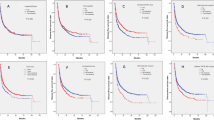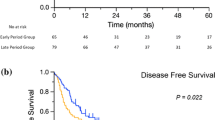Abstract
Background/Purpose. We retrospectively investigated the clinicopathologic features and outcome of 51 patients who underwent hepatectomy for intrahepatic cholangiocellular carcinoma (ICC) between 1991 and 2000, and we also analyzed the potential prognostic factors for long-term survival.
Methods. There were 27 men and 24 women, with a mean age of 63.7 years. The surgical procedures were extended right or left hepatectomy (15 cases), right or left hepatectomy (19 cases), bisegmentectomy (3 cases), segmentectomy (7 cases), and subsegmentectomy (7 cases). The macroscopic findings of the excised tumor showed the mass-forming (MF) type (31 cases), the periductal-infiltrating (PI) type (13 cases), and the intraductal growth (IG) type (7 cases).
Results. The patients with the MF type had a significantly higher incidence of lymph node metastasis (44.8%), as compared to those with the PI or IG type (15.0%). Two patients who died of hepatic failure during their hospital stay were excluded from this survival study. The cumulative 1-, 3-, and 5-year survival rates in 49 patients who underwent liver resection were 68.2%, 44.1%, and 32.4%, respectively. The patients with the IG type had the best outcome, followed by those with the PI type and MF type. The survival rates with or without lymph node metastasis were 9.0% and 60.6% at 3 years, and 9.0% and 42.9% at 5 years, respectively (P ≪ 0.05). The 1-, 2-, and 3-year survival rates in the MF-type patients with lymph node metastasis were 25.4%, 16.9%, and 0%, respectively. Eight patients (15.7%) survived for more than 5 years after operation. The gross appearance of these tumors was the PI type in 5 patients, the IG type in 2, and the IG + MF type in 1. Except for one case with the PI-type tumor, lymph node metastasis was not observed. All of the 5-year survivors underwent curative resection and none of them had any positive surgical margin.
Conclusion. Analysis of the clinicopathologic factors influencing the survival after surgical treatment showed that the macroscopic type, surgical curability, lymph node metastasis, tumor size, and cancer-free margin were the most predictive.
Similar content being viewed by others
Author information
Authors and Affiliations
About this article
Cite this article
Morimoto, Y., Tanaka, Y., Ito, T. et al. Long-term survival and prognostic factors in the surgical treatment for intrahepatic cholangiocarcinoma. J Hepatobiliary Pancreat Surg 10, 432–440 (2003). https://doi.org/10.1007/s00534-002-0842-3
Received:
Accepted:
Issue Date:
DOI: https://doi.org/10.1007/s00534-002-0842-3




